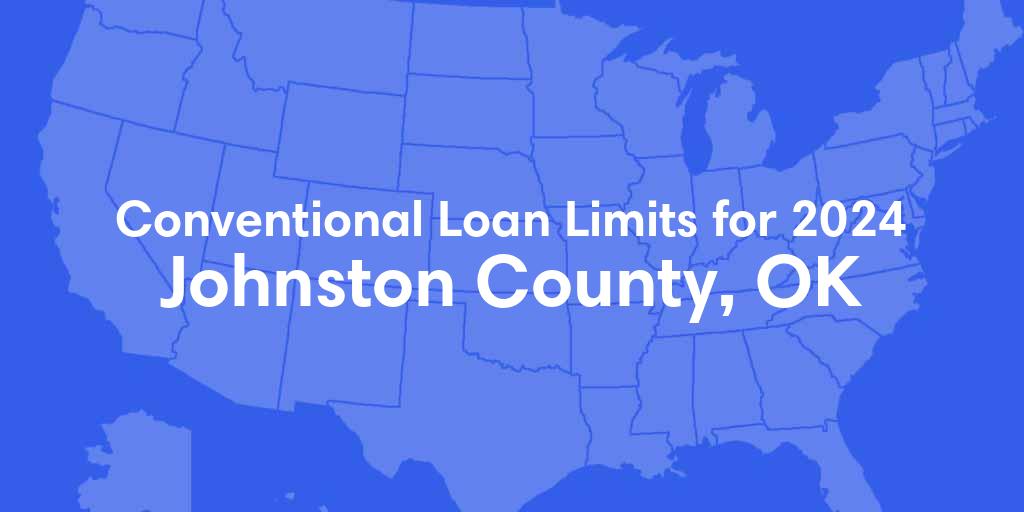Johnston County, OK Conventional Loan Limits for 2025

If you're planning to buy a property in Johnston County, Oklahoma, it's important to understand the specific Conventional Loan Limits that apply in 2025. These limits define the maximum loan amounts that lenders can provide while staying within the guidelines set by Fannie Mae and Freddie Mac.
Explore the 2025 Conventional Loan Limits for Johnston County, OK
| Number of Units | Loan Limits |
|---|---|
| One-Unit | $766,550 |
| Two-Unit | $981,500 |
| Three-Unit | $1,186,350 |
| Four-Unit | $1,474,400 |
Notes:
- One-Unit is a single-family home or condominium
- Two-Unit is two separate living units (duplex)
- Three-Unit is three separate living units (triplex)
- Four-Unit is four separate living units (fourplex)
How to Find the Best Conventional Loan for property in Johnston County, OK
Follow this steps to explore current mortgage rates in Johnston County, OK personalized for property type: Single-Family Home, Condominium, Duplex, Triplex, or Fourplex.
- Select Loan Purpose
- Enter Property Zip Code
- Enter Purchase Price
- Enter Down Payment
- Select Your Credit Score
- Click "More Options" and select Property Type
- Click "Update Lenders" to filter personalized results
Current Conventional Loan mortgage rates for Johnston County, OK
Access free, detailed loan estimates from multiple lenders in one search. Compare and find the best offer — no obligations.
Unlock My Loan EstimatesPowered by SecureRights
Conventional loan limits refer to the maximum loan amount that can be borrowed using a conventional mortgage. These limits are set by Fannie Mae and Freddie Mac and may vary by location.
Yes, conventional loan limits can change annually. They are typically adjusted to reflect changes in housing prices. It's important to check the current limits before applying for a loan.
Conventional loan limits are determined based on the conforming loan limit set by Fannie Mae and Freddie Mac. This limit is influenced by the Federal Housing Finance Agency (FHFA) and is tied to changes in the average home prices.
Yes, there are different loan limits for different types of properties. For example, the limits may vary for single-family homes, duplexes, triplexes, and fourplexes. Higher limits may apply to multi-unit properties.
Yes, conventional loan limits apply to the entire loan amount, including both the loan principal and any financed fees. Borrowers exceeding these limits may need to consider jumbo loans, which have different requirements.
Conventional loan limits can vary by county or metropolitan area, reflecting regional differences in housing costs. Higher-cost areas generally have higher loan limits to accommodate the increased property values.
If your loan amount exceeds the conventional loan limits, you may need to consider a jumbo loan. Jumbo loans typically have different eligibility criteria and may require a larger down payment and a higher credit score.
While loan limits themselves may not directly impact interest rates, exceeding these limits might lead to different loan products with potentially higher interest rates. It's essential to discuss this with your lender.
If the property price exceeds the conventional loan limits, you may need to explore alternative financing options, such as jumbo loans. Discuss your specific situation with a mortgage lender to find the most suitable solution.
Most lenders follow the conventional loan limits set by Fannie Mae and Freddie Mac. However, it's advisable to check with your specific lender, as some may have their own guidelines or may offer jumbo loans with different terms.
A conventional loan is a mortgage that is not insured or guaranteed by a government agency, such as the Federal Housing Administration (FHA) or the Department of Veterans Affairs (VA). Instead, it is backed by private lenders and follows guidelines set by Fannie Mae and Freddie Mac.
Unlike government-backed loans, conventional loans are not insured or guaranteed by the government. They typically have stricter qualification criteria and may require a higher down payment. However, conventional loans often offer more flexibility in terms of loan amounts and property types.
The minimum down payment for a conventional loan can vary, but it is typically around 3% to 5% of the home's purchase price. However, a larger down payment may be required to secure a more favorable interest rate and avoid private mortgage insurance (PMI).
PMI is a type of insurance that protects the lender in case the borrower defaults on the loan. For conventional loans with a down payment of less than 20%, PMI is usually required. Once the loan-to-value ratio improves, borrowers may be able to cancel PMI.
Credit score requirements for conventional loans can vary among lenders, but generally, a higher credit score is preferred. A score of 620 or higher is often required, but borrowers with higher scores may qualify for better interest rates.
Yes, conventional loans can be used to finance the purchase of investment properties, but the requirements may be more stringent compared to loans for primary residences. Lenders may require a larger down payment and impose stricter eligibility criteria.
Yes, there are loan limits for conventional loans, which are set by Fannie Mae and Freddie Mac. These limits can vary by location and are periodically adjusted to account for changes in housing prices. Loans that exceed these limits are often referred to as jumbo loans.
A fixed-rate conventional loan has a stable interest rate that remains constant throughout the loan term, providing predictable monthly payments. In contrast, an adjustable-rate conventional loan has an interest rate that can change periodically, potentially leading to fluctuations in monthly payments.
Yes, conventional loans can be used for refinancing existing mortgages. This can be done to obtain a lower interest rate, shorten the loan term, or access the equity in your home.
The time it takes to get approved for a conventional loan can vary, but the process generally involves submitting documentation related to income, credit history, and property details. On average, the approval process can take anywhere from 30 to 45 days, though it may be shorter or longer depending on various factors.
